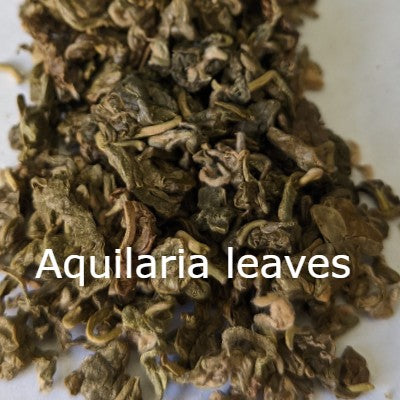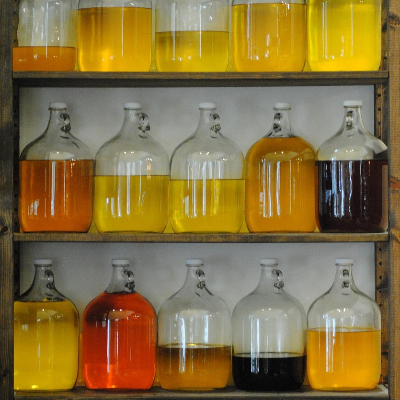Menu
-
-
F.A.Q
- How to identify genuine agarwood chip, natural or cultivated
- How to identify oil injection / absorption fake agarwood beads
- How to know if there are more than one oil in your oil
- How to make your wood bracelet or mala darker
- How to tell if an Agarwood bead sinks WITHOUT sinking it under water?
- How does back flow incense work and how do you burn it?
- Where to start if you don't know what agarwood is ?
- Why are you losing money if you buy seeds and plants?
- Which agarwood incense should I choose?
- Frequently Asked Questions
- Agarwood Related Articles
- Shipping
-
SHOP - Agarwood
-
SHOP - Other Fragrant Wood
-
SHOP - Incense Holder and Burner
-
- FREE Oud Oil guide
- Testimonials
- "Why did you buy this?"
- Contact us
- About Us
- +61430284329
- Login
-
English


How Aquilaria Leaves Can Help Fight Inflammation, Improve Your Digestion, and More
April 24, 2022 6 min read
Table of Contents:[hide]
Introduction:
Aquilaria leaves are known for their many pharmacological properties. They can help fight inflammation, improve your digestion, and more. Read on to learn more about the benefits of Aquilaria leaves and how you can enjoy them in various ways.
1. What are Aquilaria leaves?
Aquilaria leaves are the leaves harvested from Aquilaria trees. The leaves are handpicked young Aquilaria leaves only and processed and packed on the same day to preserve their freshness. The leaves are then roasted to capture their freshness and preserve their flavours.

(Source: Evergreen Agarwood plantation: Aquilaria leaves)

Source: Dried Aquilaria leaves
2. What are the pharmacological properties of Aquilaria leaves?
Aquilaria leaves have pharmacological properties that can help with a variety of issues. For one, the leaves are analgesics, meaning they can help reduce or relieve pain. They're also anti-arthritic and anti-inflammatory, making them useful for those with conditions like arthritis. Additionally, the leaves are antioxidants, meaning they can help protect the body from damage caused by free radicals. And finally, the leaves have antibacterial and antifungal activities, making them helpful in fighting infection.
(if you are interested in a full article, let me know and I will send you a link)
Mangiferin (Worathat et al 2018) is the most well-known chemical component of Aquilaria species. Mangiferin, like other chemicals in the genus Aquilaria, theoretically has the same pharmaceutical effects as it does. We'll go over mangiferin's pharmacological effects below.
3. Reducing post-meal blood sugars: Inhibitory Activities Against Alpha-Glucosidase
Mangiferin is also known to have an inhibitory effect on a range of carbohydrates, including alpha-glucosidase, sucrase, maltose, isomaltose, alpha-amylase, and aldose reductase (Mujawdiya And Kapur 2011)
This study looked at how different enzymes that help to break down carbohydrates worked. The study found that some of these enzymes were inhibited by certain activities.
Aquilaria Sinensis is reported to have alpha-glucosidase inhibitory activity (Feng et al.2011 ). The benefit of Alpha-glucosidase Inhibitory activity means reducing post-meal blood sugars and therefore helping to lower HbA1c.
In the KK-Ay spontaneous diabetes model, mangiferin and its glucoside improved blood glucose levels after an insulin tolerance test. (Miura et al.2001). Mangiferin was found in urine, blood, and feces after oral administration to conventional rats, pseudo-germ-free rats, and streptozotocin (STZ)-induced diabetic rats (Liu et al. 2012).
In rats with diabetes that were given streptozotocin, mangiferin lowered blood glucose levels and changed the levels of biochemical parameters including urea, uric acid, and creatinine.
Furthermore, red blood cell and white blood cell counts, as well as their functional indices, were significantly enhanced, while toxicological parameters including AST, ALT, and ALP levels were also considerably reduced. (Sellamuthu et al. 2014).
See below the definition of AST, ALT and ALP from Mayoclinic
- Alanine transaminase (ALT). ALT is an enzyme produced by the liver that helps to turn proteins into energy for the liver cells. When the liver is harmed, ALT is released into the blood circulation and levels rise.
- Aspartate transaminase (AST). AST is an enzyme that aids in the breakdown of amino acids. AST is typically found in blood at low concentrations, much like ALT. An increase in AST levels might indicate liver damage, illness, or muscular damage.
- Alkaline phosphatase (ALP). ALD is an enzyme produced by the liver and bone, which helps to break down proteins. High ALP levels might indicate liver damage or sickness caused by a blocked bile duct, as well as certain bone pathologies.
In the same rat diabetic model, mangiferin ameliorated blood glucose and increased plasma insulin levels. The activities of antioxidant enzymes, such as superoxide dismutase, catalase, and glutathione peroxidase, were decreased after mangiferin administration. This suggests that glucose toxicity in blood was reduced because of the mangiferin. (Sellamuthu et al. 2013). Mangiferin suppressed the overproduction of osteopontin, which led to a reduction in renal fibrosis. (Zhu et al. 2014).
Mangiferin reduced hyperglycemia, insulin resistance, and hyperlipidemia in high-fat diet-induced obesity mice. It means Mangiferin helped to reduce high blood sugar, insulin resistance, and high levels of cholesterol in mice that were obese because they ate a lot of fatty food.
The study found that the supplement increased levels of proteins important for creating new mitochondria and for making energy, while also decreasing levels of proteins important for creating fat such as fatty acid stearoyl- CoA desaturase 1 and acetyl-CoA carboxylase 1 (Lim et al. 2014).
What does it mean you may ask?
Mitochondrial biogenesis and oxidative activity is for making energy or converting sugar into energy (Medline Plus)
"Decreasing levels of proteins important for lipogenesis such as fatty acid stearoyl- CoA desaturase 1 and acetyl-CoA carboxylase 1". It means Mangiferin decrease the number of specific proteins. These proteins are responsible to create fat. In other words, reducing these proteins means reducing fat making.
4. How can Aquilaria leave help with inflammation?
Aquilaria leaves have long been used in traditional Chinese medicine for various purposes, such as reducing inflammation, aiding digestion, and more. The detection of alkaloids in Aquilaria leaves extracts indicates its potential use as an analgesic agent. Polyphenolic compounds like flavonoids exhibit anti-inflammatory activities by decreasing the release of inflammatory mediators and stabilising cell membranes. Glycosides, tannins, terpenoids, oleic acids, terpenes and phenolic compounds restrain heat-induced protein denaturation. These pharmacological properties make Aquilaria leaves a potentially valuable remedy for a range of health concerns.
5. How can Aquilaria leaves improve digestion?
Aquilaria leaves are not only bitter, but they're also rich in bioactive compounds that can improve your digestion. A study published in the BMC Complementary and Alternative Medicine journal found that the ethanol extract of Aquilaria leaves (EEA) increases contractions of the intestine to accelerate food in the digestive tract without inhibiting nutrient absorption. In other words, the EEA can help you lose weight without depriving you of essential nutrients. The researchers also found that EEA has a laxative effect, without causing diarrhoea in a rat model of low-fibre diet-induced constipation. If you're looking for an easy way to improve your digestion, Aquilaria leaves may be just what you need!
6. Are there any side effects of consuming Aquilaria leaves?
Yes, there are potential side effects associated with drinking Aquilaria leaves. But you need to consume a lot of them to feel unwell.
In a study by the Asia Pacific Journal of Molecular Biology and Biotechnology (Razaka et al. 2018), Aquilaria leaves are generally safe to drink. At or higher than 2000mg /kg body weight per day in a period of 28 days, it triggered several toxicity effects in rats.
It sounds scary, doesn't it?
In a different study for lethal dose in green tea, green tea extract was given to mice for 14 weeks, they found that concentrations above 1,000 mg per kg of body weight were lethal (Chan et al. 2010)
Let's suppose whatever works in a rat may work in a human, it means if a human is 60kg of weight, he needs to brew 60g of green tea and drink it everyday for 14 weeks to be poisoned.
On average, 10g of tea leaves can make 1 litre of tea and you can re-steep 3 times. Even if you do not re-steep the tea, you need to drink 6 litres of tea a day for 14 week s to get sick. To have adequate of water intake daily, a man drinks 4.7 Litres a day while a woman consumes 3.7 litres (Mayo Clinic NA). So drinking 6 litres of tea a day is unlikely to happen.
Aquilaria leaves is LD50 2000mg /kg body weight on rat compared to Green Tea 1000mg /kg body weight
In short, it is generally safe if you brew no more than 1g of leaves per day and consume no more than 5g a day in total. And in the unlikely event that you discover something is not right after drinking Aquilaria leaves, stop consuming further. Some of the key compounds found in Aquilaria leaves are sesquiterpenes, which have anti-inflammatory and analgesic properties. Generally, Aquilaria leaves are safe to consume and provide potential health benefits.
Conclusion:
Aquilaria leaves are a powerful and all-natural way to fight inflammation, improve digestion, and boost your overall health. With their anti-inflammatory, antibacterial, and antioxidant properties, Aquilaria leaves can help you feel your best. Plus, their laxative effects can help you with bowel movements and keep your digestive system healthy. Aquilaria leaves are a safe and healthy way to improve your health, so why not give them a go?
Click here to order our Aquilaria leaves (Agarwood tea) today
** Disclaimer: the above information
This statement has not been evaluated by the Food and Drug Administration and Therapeutic Goods Administration. This product is not intended to diagnose, treat, cure, or prevent any disease
Leave a comment
Comments will be approved before showing up.
Also in News

What is Tasbih? The Deep Meaning of Subhan Allah and the Role of Prayer Beads
November 09, 2025 4 min read

